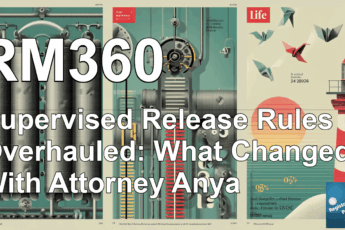Introduction: Why Legal Rehabilitation Matters
The legal system, at its core, is meant to balance justice, accountability, and opportunities for redemption. Nowhere is this balance more evident than in legal proceedings involving petitions for rehabilitation and pardon. A recent ruling from the California Court of Appeal in People v. Rounds sheds light on the complexity surrounding such cases. George Dennis Rounds Jr.—once convicted of severe crimes—found himself presenting a case for meaningful rehabilitation decades after his conviction. What makes this case pivotal isn’t just the legal arguments but the larger themes it underscores about redemption, justice, and the rule of law.
This article unpacks the key aspects of People v. Rounds, including arguments from both sides, the legal foundations for rehabilitation, and what this case signals for the justice system. Whether you’re a legal practitioner, a student of law, or a curious observer, this case offers a window into how courts grapple with the tension between respecting victims’ experiences and recognizing meaningful personal change.
Setting the Stage: The Case of George Dennis Rounds Jr.
George Dennis Rounds Jr. was convicted in 1983 of second-degree murder and attempted murder—serious crimes that led to substantial consequences. After serving his sentence, Rounds was paroled in 2010 and subsequently discharged from parole in 2014. Fast forward to 2021, when Rounds filed a petition for a certificate of rehabilitation and pardon.
The certificate of rehabilitation serves as a formal acknowledgment of an individual’s transformation post-incarceration, often paving the way for clemency recommendations or a full pardon. For Rounds, this was a chance to document decades of reform, rehabilitation, and efforts to reintegrate into society as a law-abiding, contributing citizen. However, as expected, the district attorney’s office opposed his petition with a slew of arguments.
Opposition Arguments: Why the State Objected
The district attorney (DA) strongly opposed Rounds’ petition, claiming that he failed to meet the required criteria for rehabilitation, specifically focusing on three pillars:
- Insight Into His Crimes: The DA argued that Rounds lacked sufficient insight into the nature of his crimes—the harm he caused his victims and their families—and failed to fully acknowledge the severity of his actions.
- Accountability and Responsibility: They criticized his explanations of the events surrounding his crimes, suggesting inconsistencies that undermined his claims of taking full responsibility.
- Moral Transformation and Restoration: Finally, they contended that Rounds hadn’t provided enough evidence of being restored to moral character and fitness—a crucial benchmark for regaining certain rights lost due to his conviction.
These arguments are not uncommon in cases where individuals seek rehabilitation. The burden of proof falls on the applicant to not just show good behavior post-incarceration but also to demonstrate accountability and their reintegration into civil society. The trial court, agreeing with the DA, denied Rounds’ petition.
Presentation of Rehabilitation: Rounds’ Case for Redemption
Despite the DA’s opposition, Rounds presented a compelling argument centered on his accomplishments and the significant strides he had made toward rehabilitation. Key highlights of his case included:
- Community Service: Rounds dedicated substantial effort to mentoring and supporting his community, including working with programs like Operation New Hope.
- Education: He pursued higher education, earning an Associate of Arts degree and a certification as a radiologic technologist, showcasing his commitment to self-improvement.
- Employment Stability: His seven-year tenure with Amazon stood out as a marker of his reliability and reintegration. Maintaining stable employment—particularly in such a challenging corporate environment—reflects enduring personal change.
- Entrepreneurship and Mentorship: As the founder of Driven Bound LLC, Rounds actively mentored male youth, teaching life skills and promoting positive transformation.
- Support From Community Leaders: Letters from community members, colleagues, and family members attested to his high moral character, further emphasizing his post-release contributions.
Despite this robust framework of evidence, the trial court denied the petition. Their reasoning? The severity of Rounds’ original crimes and considerations for the victims’ experiences—a decision the appellate court later scrutinized.
The Appellate Court’s Intervention: Correction of Errors
The California Court of Appeal reversed the trial court’s denial, pointing to what they deemed a misuse of discretion in the lower court’s decision. The appellate court emphasized that rehabilitation petitions should be assessed based solely on statutory criteria, not extraneous considerations such as the nature of the original crime or victim fairness.
Statutory criteria for rehabilitation generally include:
– Evidence of good moral character post-release
– Demonstrated adherence to the law
– Active participation in community and personal betterment efforts
The appellate court found Rounds had met these benchmarks. They concluded that the trial court erred by treating factors outside the legal framework—like the severity of his past crimes—as fundamental to their decision. To correct this, the appellate court not only reversed the denial but went one step further, directing the trial court to grant Rounds’ petition.
Implications of the Appellate Decision
This ruling in People v. Rounds serves as a critical reminder of the legal system’s role in supporting rehabilitation while adhering to the rule of law. It reinforces a few key principles:
- Focus on Current Effort, Not Past Crimes
While an individual’s criminal record matters in some contexts, laws governing rehabilitation place greater emphasis on post-incarceration behavior. Redemption is measured by actions taken after wrongdoing, not the wrongdoing itself. - Limits of Judicial Discretion
Though trial courts have significant leeway in decisions about rehabilitation petitions, the appellate court’s ruling reinforces that this discretion has limits. Courts must operate within statutory parameters, not subjective judgments. - Opportunity for Second Chances
At its heart, this case serves as a testament to the justice system’s ability to extend second chances. It highlights a legal structure that can both hold individuals accountable and provide pathways for redemption when genuine efforts are made.
Lessons on Rehabilitation and the Rule of Law
The People v. Rounds decision carries broader lessons for the justice system and how society views rehabilitation. First, it underscores the importance of post-release opportunities for individuals who demonstrate genuine reform. Punishment shouldn’t necessarily prevent individuals from reclaiming their lives.
Second, it reinforces the idea that the rule of law should prevail over subjective considerations. In cases like Rounds’, judicial decisions must adhere strictly to what statutes require and avoid being swayed by emotional or moralistic factors outside the law’s scope.
Lastly, it’s a timely reminder that rehabilitation isn’t just about the individual—it’s about the opportunity for societal healing. Someone like George Dennis Rounds Jr., who dedicates his post-release life to community service, mentorship, and positive contributions, becomes a living example of how the system can produce meaningful redemption stories.
Conclusion: A Case That Illuminates the Path Forward
The People v. Rounds decision is more than just a legal victory for one man—it’s a beacon for reform in the criminal justice system. It tells a story of resilience, the legal process’s capacity for fairness, and the balancing act between accountability and second chances.
What this case teaches us is straightforward yet profound: redemption is a cornerstone of justice. As we continue to evaluate the future of rehabilitation laws, stories like George Dennis Rounds Jr.’s remind us of the need to create systems that honor both the rule of law and the transformative power of human effort.
Actionable Takeaways:
- For legal professionals: Approach rehabilitation petitions with an understanding of statutory priorities and post-release contributions.
- For policymakers: Advocate for legislative clarity on what factors can and should be considered in rehabilitation cases.
- For individuals: Recognize that meaningful reform is possible, and actions taken post-incarceration can have a lasting impact.
The journey of George Dennis Rounds Jr. isn’t just an isolated legal case—it’s a mirror held up to the justice system, reflecting both its challenges and its promise.




Leave a Comment